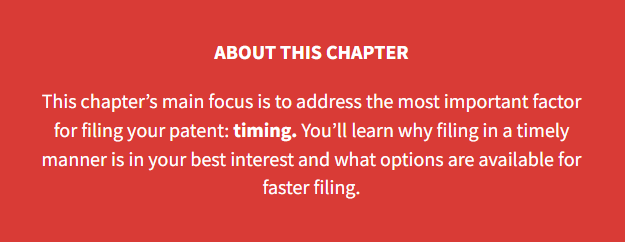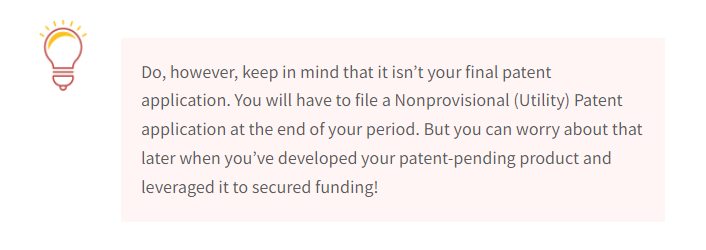Chapter 2

Why you need to file for a patent NOW!
As discussed in Chapter 1 — a patent is vital to your business’s success and future profitability. Once you’ve made the decision to file, it’s important that you understand why filing sooner rather than later is absolutely necessary.
With such high velocity, filing for a patent should not be a time-consuming process as it could cost you your invention and future business profits.
When it comes to filing for a patent, it doesn’t matter when you will obtain the patent itself as the patent filing process sometimes takes months. What matters, however, is the filing date. It’s a first-to-file game and we want you to win!
Complete transcript available here
How long does it take to get a patent?
The answer varies, of course, depending on many factors.
Let’s start with the country. Patents are a per country right. According to the USPTO (US Patent and Trademark Office), it takes about 24 months to get a patent approval after filing your patent application. A fast track examination might lead to approval in six to 12 months, but you have to qualify.
However, the length of time to get a patent in the US varies according to the technical area. For example, most software applications fall in a technical area that averages up to 37 months to get a patent.
According to other sources, approval length could be up to 37 months in Canada, 3 years in China, and 5 years in Europe. But it currently takes up to 14 years in Brazil(!).
But you also have to include the time to do a patent search and draft the patent application.
The patent process timeline:
-
Patent searching (1 week to 6 months)
-
Drafting the patent application (2 to 4 weeks)
-
File to acceptance (see above for per country timing)
These are average wait lengths. The invention's complexity and who it is assigned to determine the length of patent approval or rejection. Depending on the patent office’s queue, this could mean shorter or longer wait time.
How you can file now!
All you need to get started is a detailed description of your idea and a few patent drawings.
We recommend filing a Provisional Patent Application, instead of a Non-provisional (Utility) patent application right away.
There are many reasons why a Provisional Patent is better, but here are the top 3:
-
You can file faster. Get that filing date in quickly! Provisional applications are far less complex and much more simple to file.
-
You can keep working on your idea. Provisional, as it says in the name, is valid for 12 months. After those 12 months, you’ll need to file a full patent application or lose the patent protection rights. This gives you plenty of time to keep working and improving your product or business.
It’s much more affordable and it has a really quick turnaround. Perfect for fast-growing companies!
How do I know if my idea is patentable?
For an invention to be eligible for patent protection, it must fulfill certain criteria. The invention must fit into a patentable category. The invention must also be new, non-obvious, and useful.
The patentable categories include any type of technology. The categories of inventions that can qualify for a utility patent include:
-
Hi-Tech, including hardware, software, and electronics
-
Material compositions such as combinations of chemicals, foods, and living organisms
-
Machines, which can be as simple as an umbrella or as complex as a robot
-
Life science technology, including pharmaceuticals, medical devices, proteins, and more

To determine whether your invention may qualify for a patent, ask the following questions:
-
Does the invention fall into a patentable category? If your invention doesn’t relate to some type of technology as described above, it won’t qualify for a patent.
-
Is the invention new? To be eligible for a patent, your invention must be different than anything else that is currently sold to the public, written or published, or patented. You may want to hire a patent agent to conduct a prior art search.
-
Is the invention non-obvious? That is, does it have a “wow” factor? The patent office will compare your invention to what is already known, to decide whether it is really inventive.
-
Does the invention have utility? If your invention doesn't have a specific use (i.e the invention is abstract), it cannot be patented.
What is a Provisional Patent Application?
Complete transcript available here
The provisional patent application is not the same as a full, granted patent application. A provisional patent application is filed exclusively at the USPTO (US Patent and Trademark Office). Consider the provisional patent application as a preliminary patent application. There are a few key differences between a provisional and a full patent.
Here’s how a provisional patent application is different:
-
It has fewer requirements and a more straightforward application process. Because of these factors, the provisional patent application is a perfect solution for those who want to file first and obtain coverage over their ideas, then file for a full patent later.
-
It doesn't turn into a full patent application automatically - you still have to file for a full (utility) patent application. The provisional patent application will require you to file a full patent application within a year.
-
The official patent examination won't start before the end of your provisional application period, which is up to one year from the filing date. However, you still have to meet the patent filing requirements of the USPTO for your provisional. If your full patent application is vastly different from the description of your provisional application, your provisional may not give you the coverage that you need.
Provisional patent applications are great for those innovators who want to file first. Remember, the first patent to be filed for an idea — whether a provisional or a full (utility) patent — wins. Once you have filed, you are allowed to use the "patent pending" designation. A Provisional Patent Application is a patent application that can be used to secure a filing date while avoiding the high costs associated with filing and prosecution of a Nonprovisional (Utility) Patent Application.
It is highly recommended for those filing a provisional patent application to consider involving a patent attorney or agent to get the best coverage for your idea.
The provisional application has straightforward documentation. It includes a cover sheet, written documentation of your application, and the fees for the application. In addition, we strongly recommend preparing patent drawings as well.
Keep in mind, we specialize in provisional patent applications. If you have any further questions on provisionals, please reach out to us.
Here are some key benefits of filing a Provisional:
-
Fewer requirements. Provisional applications are perfect for those who want to get protection quickly!
-
Gain an additional year. You’ll be able to experiment, perfect your invention, find financial backing, determine sales potential, find interested parties for licensing, etc.
-
Not examined. Avoid the costs of prosecuting a nonprovisional application during this one-year period.

What is the difference between the US patent types ‘grant’ and ‘application’?
A granted or issued US patent is an actual patent. It can be enforced in court if someone infringes — or trespasses — on the claims of the patent. The claims are the section of the patent which defines the patent right that has been given. Before your patent is granted, you have a patent pending.
A US patent application is a request to obtain a patent. US patent applications are usually published 18 months after the initial filing date.
The claims in a patent application may change after publication, and in fact, usually, do. This is because the US patent examiner will compare the claims to the prior art, and may require the applicant to change the claims in order to obtain a granted patent. The prior art is everything published before the initial filing date of the patent, everywhere in the world, and in every language.
Sometimes US patent applications become abandoned before they are granted. This can happen for many reasons. For example, the examiner may find prior art that shows that the invention in the patent application isn’t new (novel) or is too similar to the prior art (obvious).
Wondering if your idea is patentable? Have a question about this article? We can answer all of your questions — just hit "contact us" down below!
CONTINUE YOUR JOURNEY BY CLICKING ON THE CHAPTER LINKS
-
What Is a Patent and Why Do You Need One



